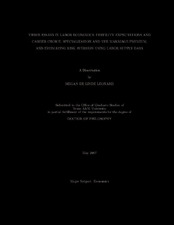| dc.contributor.advisor | Ureta, Manuelita | |
| dc.creator | Leonard, Megan de Linde | |
| dc.date.accessioned | 2010-01-15T00:01:43Z | |
| dc.date.accessioned | 2010-01-16T01:34:44Z | |
| dc.date.available | 2010-01-15T00:01:43Z | |
| dc.date.available | 2010-01-16T01:34:44Z | |
| dc.date.created | 2007-05 | |
| dc.date.issued | 2009-05-15 | |
| dc.identifier.uri | https://hdl.handle.net/1969.1/ETD-TAMU-1282 | |
| dc.description.abstract | Women, on average, are found in systematically different careers than men. The
reason for this phenomenon is not fully understood, in part because expectations play
a vital role in the process of career choice. Different religious groups have different
beliefs on the importance of child bearing, so fertility expectations should differ by
religious group. I include a woman's religious denomination in regressions on mea-
sures of occupational flexibility. Jehovah's Witnesses choose the most flexible careers
followed by Pentecostal, Catholic, Baptist, and Mainline Protestant women. Jewish
women generally choose the least flexible careers. This is consistent with the human
capital notion that women are choosing different careers than men rather than being
forced into different job paths.
If women are choosing jobs that allow them to take responsibility for home pro-
duction, how does this affect their husbands? Male wage regressions that include
marital status dummy variables find a marriage wage premium of 10 to 40%. This
premium may occur because wives are taking responsibility for home production and
husbands are free to focus their attention on productivity at work. It may also be
that factors unobserved to the researcher may make a man more productive and more
likely to marry. I use religious denomination as a proxy for specialization within the
home. Men in more traditional religious denominations enjoy a higher marriage wage
premium, which is evidence that household specialization of labor is an important cause of the wage premium.
The choice of a career, whether to marry, and most other important life decisions
are dependent on one's risk tolerance. The role of risk preferences in such choices is
not fully understood, largely because relative risk aversion (y) is hard to empirically
quantify. Chetty (2006) derives a formula for ° based on the link between utility and
labor supply decisions. I estimate y at the micro level using the 1996 Panel Study
of Income Dynamics. I compare y to an estimate based on hypothetical gambles
and find the measures substantially different. This supports Chetty's claim that ex-
pected utility theory cannot suffciently explain choices under uncertainty in different
domains. | en |
| dc.format.medium | electronic | en |
| dc.format.mimetype | application/pdf | |
| dc.language.iso | en_US | |
| dc.subject | Career choice | en |
| dc.subject | male marriage wage premium | en |
| dc.subject | risk aversion | en |
| dc.title | Three essays in labor economics: fertility expectations and career choice, specialization and the marriage premium, and estimating risk aversion using labor supply data | en |
| dc.type | Book | en |
| dc.type | Thesis | en |
| thesis.degree.department | Economics | en |
| thesis.degree.discipline | Economics | en |
| thesis.degree.grantor | Texas A&M University | en |
| thesis.degree.name | Doctor of Philosophy | en |
| thesis.degree.level | Doctoral | en |
| dc.contributor.committeeMember | Deere, Donald | |
| dc.contributor.committeeMember | Mayer, Adalbert | |
| dc.contributor.committeeMember | Taylor, Lori | |
| dc.type.genre | Electronic Dissertation | en |
| dc.type.material | text | en |
| dc.format.digitalOrigin | born digital | en |


